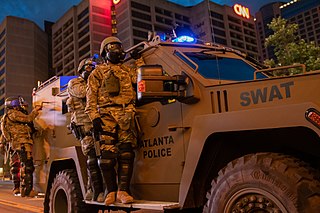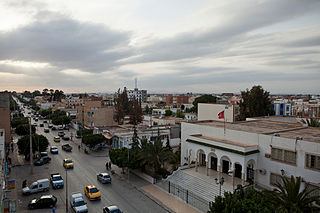
A curfew is an order that imposes certain regulations during specified hours. Typically, curfews order all people affected by them to remain indoors during the evening and nighttime hours. Such an order is most often issued by public authorities, but may also be given by the owner of a house to those living in the household. For instance, children are often given curfews by their parents, and an au pair is traditionally given a curfew by which time he or she must return to his or her host family's home. Some jurisdictions have juvenile curfews which affect all persons under a certain age not accompanied by an adult or engaged in certain approved activities.
The 2001 Cincinnati riots were a series of civil disorders which took place in and around the Over-the-Rhine neighborhood of downtown Cincinnati, Ohio from April 9 to 13, 2001. They began with a peaceful protest in the heart of the city on Fountain Square over the inadequate police response to the police shooting of unarmed African American 19-year-old Timothy Thomas. The peaceful protest soon turned into a march that went in the direction of the victim's home neighborhood of Over-the-Rhine.

The 1966 Hong Kong riots, also known as the 1966 Star Ferry riots, were a series of disturbances that took place over four nights on the streets of Kowloon, Hong Kong in the spring of 1966. The riots started as peaceful demonstrations against the British colonial government's decision to increase the fare of Star Ferry foot-passenger harbour crossing by 25 percent.

Sidi Bouzid, sometimes called Sidi Bou Zid or Sīdī Bū Zayd, is a city in Tunisia and is the capital of Sidi Bouzid Governorate in the centre of the country. Following the suicide of Mohamed Bouazizi in Sidi Bouzid, it was the site of the first clashes of the Tunisian Revolution and a catalyst for other protests in the region, often known as the Arab Spring.

The Tunisian revolution, also called the Jasmine Revolution and Tunisian Revolution of Dignity, was an intensive 28-day campaign of civil resistance. It included a series of street demonstrations which took place in Tunisia, and led to the ousting of longtime dictator Zine El Abidine Ben Ali in January 2011. It eventually led to a thorough democratization of the country and to free and democratic elections, which had led to people believing it was the only successful movement in the Arab Spring.

The 2010–2012 Algerian protests were a series of protests taking place throughout Algeria, lasting from 28 December 2010 to 10 January 2012. The protests had been inspired by similar protests across the Middle East and North Africa. Causes cited by the protesters included unemployment, the lack of housing, food-price inflation, corruption, restrictions on freedom of speech and poor living conditions. While localized protests were already commonplace over previous years, extending into December 2010, an unprecedented wave of simultaneous protests and riots, sparked by sudden rises in staple food prices, erupted all over the country starting in January 2011. These were quelled by government measures to lower food prices, but were followed by a wave of self-immolations, most of them in front of government buildings. Opposition parties, unions, and human rights organisations then began to hold weekly demonstrations, despite these being illegal without government permission under the ongoing state of emergency; the government suppressed these demonstrations as far as possible, but in late February yielded to pressure and lifted the state of emergency. Meanwhile, protests by unemployed youth, typically citing unemployment, hogra (oppression), and infrastructure problems, resumed, occurring almost daily in towns scattered all over the country.

Ahmed Najib Chebbi or simply Najib Chebbi is a Tunisian attorney and politician.

Tarek El-Tayeb Mohamed Bouazizi was a Tunisian street vendor who set himself on fire on 17 December 2010 in Sidi Bouzid, Tunisia, an act which became a catalyst for the Tunisian Revolution and the wider Arab Spring against autocratic regimes. His self-immolation was in response to the confiscation of his wares and the harassment and humiliation inflicted on him by a municipal official and their aides.

The Arab Spring or the First Arab Spring was a series of anti-government protests, uprisings and armed rebellions that spread across much of the Arab world in the early 2010s. It began in Tunisia in response to corruption and economic stagnation. From Tunisia, the protests then spread to five other countries: Libya, Egypt, Yemen, Syria and Bahrain. Rulers were deposed or major uprisings and social violence occurred including riots, civil wars, or insurgencies. Sustained street demonstrations took place in Morocco, Iraq, Algeria, Lebanon, Jordan, Kuwait, Oman and Sudan. Minor protests took place in Djibouti, Mauritania, Palestine, Saudi Arabia and the Moroccan-occupied Western Sahara. A major slogan of the demonstrators in the Arab world is ash-shaʻb yurīd isqāṭ an-niẓām!.

On April 12, 2015, Baltimore Police Department officers arrested Freddie Gray, a 25-year-old African American resident of Baltimore, Maryland. Gray's neck and spine were injured while he was in a police vehicle and he went into a coma. On April 18, there were protests in front of the Western district police station. Gray died on April 19.

The Tunisian bread riots were a series of violent demonstrations in Tunisia that occurred from December 1983 to January 1984, triggered by a rise in the price of bread due to an IMF-imposed austerity program. President Habib Bourguiba declared a state of emergency and the riots were put down by force. Over 100 rioters died. The regime was weakened by the upheavals and the aftermath of food riots. Three years later General Zine El Abidine Ben Ali seized power in a coup.
The 2016 siege of Sur, also known as the Sur curfew took place as part of the Kurdish–Turkish conflict in Sur district of Diyarbakir in Turkey, lasting for more than 3 months and destroying much of the neighbourhood. Heavy artillery and machine gun fire was utilized during clashes in the city involving the Turkish army and police against the Kurdish militants. At least 25 people had been killed in Sur by early March 2016, with rights groups reporting more than 200 killed by the end of the siege on 10 March. The HDP party said that most of the casualties were civilians.

The 2016–2017 unrest in Kashmir, also known as the Burhan aftermath, refers to protests in the Indian state of Jammu and Kashmir, chiefly in the Kashmir Valley. It started after the killing of militant leader Burhan Wani by Indian security forces on 8 July 2016. Wani was a commander of the Kashmir-based Islamist militant organisation Hizbul Mujahideen.
In January 2018, protests occurred in Tunisia, these protests were the result of economic hardships that Tunisians dealt with. The 2018 Tunisian protests were a series of protests occurring throughout Tunisia. Beginning January 2018, protests erupted in multiple towns and cities across Tunisia over issues related to the cost of living and taxes. As of 9 January, the demonstrations had claimed at least one life, and revived worries about the fragile political situation in Tunisia.

Crowd control in Jammu and Kashmir is a public security practice to prevent and manage violent riots. It is enforced by police forces through laws preventing unlawful assembly, as well as using riot control agents such as tear gas, chili grenades, and pellet guns.

The Second Arab Spring is a series of anti-government protests which took place in several Arab world countries from late 2018 onwards.
The 2021 Tunisian protests were a series of protests that started on 15 January 2021. Thousand of people rioted in cities and towns across Tunisia, which saw looting and arson as well as mass deployment of police and army in several cities and the arrest of hundreds of demonstrators.
The following lists events that happened during 2016 in the Tunisian Republic.

The 2021 Tunisian self-coup took place on 25 July 2021, when Tunisian President Kais Saied dismissed the government of Hichem Mechichi, suspended the Assembly of the Representatives of the People and revoked the immunity of its members. Described as a self-coup, the move came after a period of political instability marked by a series of protests against the Ennahda-backed government and the collapse of the Tunisian healthcare system amidst the COVID-19 pandemic in the country.
The 2021 Kawardha riots were incidents of religious violence between Hindus and Muslims that occurred in Kawardha, Chhattisgarh, India, between 3 and 7 October 2021.













